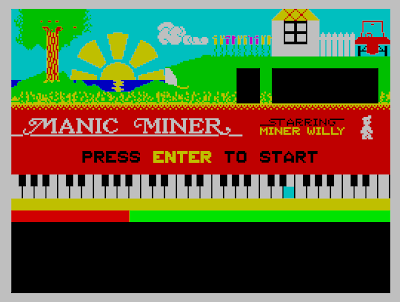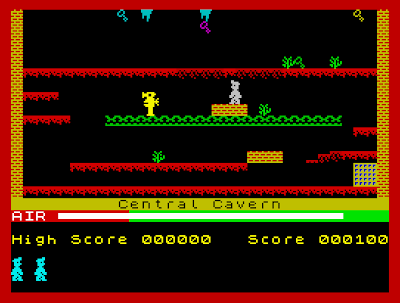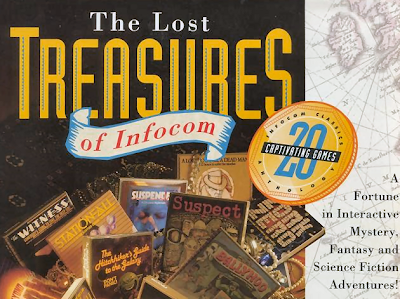1. Let's start with a bit on you. Uhm, what can you tell our readers about yourself?My name is Rudy Marchant, a Belgian in his mid-thirties. I live in a small village in Slovenia (that tiny country on the sunny side of the Alps) and basically have 2 very different occupations: 1) independent trader on the US stock market and 2) my little obsession: Sierra On-Line. I know... weird combination...
2. And how did you get into gaming; adventure gaming in particular?When I was about 7 years old, around 1983, I spent a night at my cousin's house. It was the first time I saw and played with a console. I remember playing Pacman and Space Invaders until the early hours. I was hooked immediately. It would however take several more years before I would play a game again, but I never forgot the thrill of playing those arcades. Then one day in 1988, my father brought a copy of King's Quest IV home from work. It was rather exceptional since my parents considered computer games to be a waste of time. I didn't care which company developed the game, or that it weren't the original floppies. It was the first game i played in many years, and my first adventure game. Then in the early nineties, since I still couldn't afford to buy games myself, I started getting copies of games from class mates in high school. The games were from different styles and publishers: Indiana Jones and the Last Crusade, Dune 2, Wolfenstein, Street Fighter 2, among others. Halfway the nineties I started making some money with small student jobs, and of course that went all into computer games.
3. Why Sierra?One of the first games I bought was Sierra's 15th anniversary King's Quest Collection. Obviously because I had played King's Quest IV to death, I was curious to play the other titles as well and loved every bit of them. The King's Quest collection came with a Sierra games catalog, so that's how I became familiar with all the Sierra titles of those days. Imagine discovering Space Quest, Police Quest, Leisure Suit Larry, Gabriel Knight, Phantasmagoria and more in just a couple of minutes by leafing through that little booklet! At the same time these titles were released as Sierra Originals (budget re-releases), so with my tiny budget I started buying the Sierra Originals which seemed most appealing to me. First the most appealing by the cover: Larry 6, lol. Then followed Gabriel Knight 2, Phantasmagoria, and so on, usually one new title per month. It went on like that for years and a small Sierra collection was born.
 4. When did you decide to start collecting Sierra games?
4. When did you decide to start collecting Sierra games?The real collecting started not so long ago actually. Around 2003 I joined the official Sierra forums and learned the most about Sierra On-Line and their massive game range. All I knew thus far were the games they released since halfway the nineties. With exception of the Quest series, I hadn't even heard of the other classics, such as Laura Bow, the Conquests games, Manhunter, the Hi-Res Adventures and so on. That's also when I found out the horrible truth that Sierra On-Line as independent designer and publisher in fact didn't exist any more since the CUC fraud and 1999's Chainsaw Monday. In addition to playing Sierra's games, I got intrigued by the corporation itself and its people. The Sierra forums and its members, many of which I am still in contact with to this day, were a rich source of information. I began digging all over the internet for any information I could find, over the years gathering extensive knowledge on Sierra's corporate history, every single game they released, every company they worked with, and more. I guess that's when the obsession knocked in. Then I opened an eBay account and started gradually acquiring all these games from 1980 on.
5. And why not just the Sierra developed games?That is actually a tricky question, because what is a Sierra developed game? Some would consider it only those games published by the Oakhurst studio, but even some of the old Sierra games were outsourced to other external developers, such as the Manhunter games (by Evryware) and Thexder games (by GameArts). Other people would also include the games of Sierra's acquired companies such as Impressions, Papyrus, Coktel Vision and Dynamix, companies which continued existing several more years after the Oakhurst studio was closed. By the time I knew Sierra's history, my collection already contained many games of which development was fully outsourced, published by Vivendi Games with just the Sierra logo printed on it. In addition, since I had become a moderator on the Sierra forums, I needed to stay up to date with the latest Sierra/Vivendi releases to help out the gaming community with technical and gameplay issues. Besides, there are many Vivendi/Sierra games, which I thoroughly enjoy, so I figured I might as well collect everything from 1980 to 2008. 2008, the year that Activision and Vivendi Games merged, is where the collection ends.
6. So, how many titles have you got?I currently have around 330 different boxes, Sierra only, and the collection expands by about five boxes per month. Still a long way to go. As for the number of titles, I have no idea. Some titles I have multiple times in different releases and some boxes contain multiple titles.
7. What would you say are your three most prized possessions?3) Ultima I: The Original. This is the 1983 release under the SierraVenture logo of the legendary RPG, made by Lord British. Not extremely hard to find, but hard to get. It occurs once or twice per year on eBay but is highly sought by collectors and bids run quite high every time.
2) Hi-Res Adventure #4: Ulysses and the Golden Fleece, the 1982 SierraVenture re-release in large folder. Not only hard to find but also still shrink-wrapped.
1) Hi-Res Adventure #1: Mystery House, the On-Line Systems release. It's the first game ever made by Sierra On-Line (back in 1980 still named "On-Line Systems") and the first computer game ever with graphics. My 7-year search for it finally ended last month. In addition, Ken and Roberta Williams (founders of Sierra On-Line and makers of the game) have kindly agreed to autograph it. So yes, this one has a definite first place.
8. Tell us a bit about the amazing Sierra Chest website.I was planning to make a website about Sierra On-Line years before the Chest was created, but didn't do it due to my lack of programming skills. When it was announced on the former Sierra forums that, following the Activision-Blizzard merger, the Sierra forums were going to be taken down, that triggered me to launch the
Sierra Chest in October 2008. Some other forum members also started their own Sierra fansite at that time and these individual independent sites are connected through a portal, known as the Sierra Gateway, of which the Sierra Chest is also a member.
I hired a programmer to create the basic design of the Chest: the layout, the underlying databases and the programming code. Then it was just a matter of filling up the databases with texts, images, videos and more. All this content is inserted by me. The site is a long-term project and will eventually contain every game developed and/or published by Sierra On-Line from 1980 to 2008, so also the Vivendi Games released under the Sierra logo. Each inserted game is covered in detail, with video and text walkthroughs, making-of sections, tech support, credits, strategies, music, demos, wall papers, you name it. In addition there will be a detailed corporate history, tons of biographies, printed publications (catalogs, InterAction magazines,...) and lots more. It's a lot of work, but it's all gradually happening.
In addition to the Sierra Chest site, there is also its Facebook profile. About a year ago, i set it up with the intention to market the site a bit more. What I did not expect however was that, pretty soon, Sierra alumni would join up as well. The word spread around pretty fast and now there are nearly 100 Sierra alumni on the
Sierra Chest's Facebook profile. It is astonishing how these people, more than 10 years after Sierra's demise, are still connected with their fans and each other, talking about the good old days and sharing their stories. They also often help me out, providing additional information about the games, pictures, concept art, and such. They are very open and helpful and I learn new things from them almost every day.
9. Any particular Sierra (though not necessarily Sierra only) plans for the future?I assume you mean plans for the Sierra Chest? If I'd have a few million bucks to spare, I'd probably be crazy enough to go knock on Activision's door with particular intentions though, lol.
As for the Chest, yes, aside from inserting game data, which is a continuous job, I'm also expanding the site to a new level. So far the Chest is purely an informative site. I want to make it more interactive, so the Sierra fans can also contribute to the site's content and get more fun from it. This would involve setting up site membership, new forums, some online Flash games, allowing members to upload screenshots, write reviews and so on. The more site members visit and contribute, the more features get unlocked, such as collectibles, new Flash games, Sierra music and so on. In addition it would help me a great deal as the members would lift some work of my own shoulders, speed up the growth of the site, and have fun in the process.
10. What would your advice to starting collectors be?Each game is a labor of love by its makers and has its own story. Research what you collect. If you research Sierra On-Line and discover its rich history, then the collection gets a far deeper meaning.













































